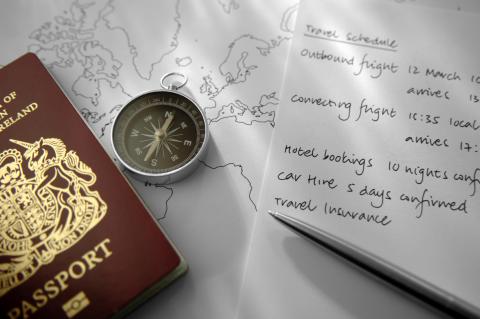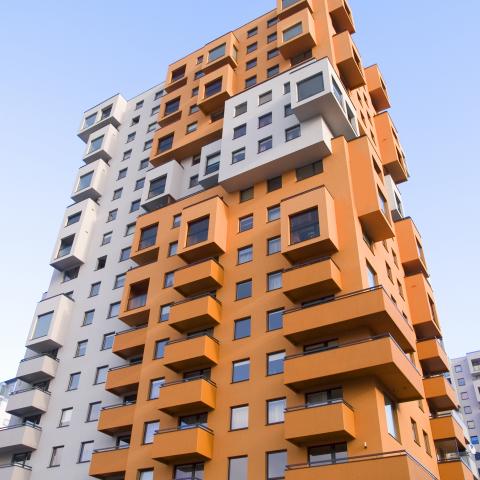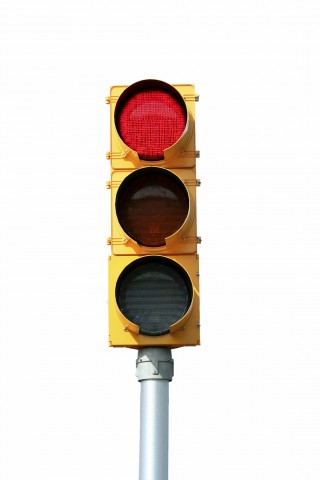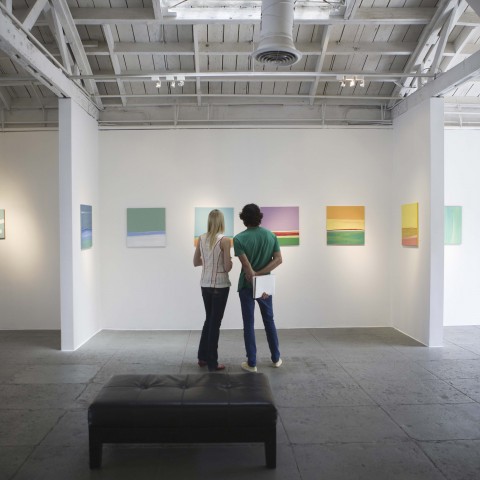
Did you ever just kinda…skip over the directions chapter in a language book?
Sitting at home or in your classroom, it’s hard to imagine yourself in the position of actually needing to know how to say these phrases.
But I actually just went traveling to a new country where I barely spoke the language, and I noticed right away that I needed to talk about directions if I wanted to find out where anything was.
Now, just for you, we’ve arranged the most critical directions in Arabic: right to left, the cardinal directions, and handy phrases you’ll be glad you know! We’ve also included some ways you can expand your knowledge and end up speaking more Arabic than you thought possible!

Table of Contents
- Basic Cultural Notes and Phrases
- The Compass Points: A Bird’s Eye View of a City
- City Vocabulary and Reference Points
- Phrases for Directions in Arabic, Part 1: Asking Others
- Phrases for Directions in Arabic, Part 2: Giving Directions
- Travel Time
- How to Use Directions as Language Practice
- Conclusion
1. Basic Cultural Notes and Phrases

Since the system of etiquette in Arab countries may be different from what you’re used to, let’s very quickly go over a bit of cultural background.
On the street, men should avoid directly talking to women who are strangers, and vice-versa. You should instead find someone of your own gender to stop and ask directions of.
Police in Arab countries will happily give you directions, but they don’t often hang out on the street unless they’re directing traffic or something. Definitely don’t stroll up to a police car to ask the people inside, as they’ll be quite surprised.
When you want to get someone’s attention, you can say:
- عَفواً!
ʿafwan!
Excuse me!
Or maybe:
- هَل يُمكِنُكَ مُساعَدَتي؟
hal yumkinuka musāʿadatī?
Could you help me?
2. The Compass Points: A Bird’s Eye View of a City

Let’s start out with the fundamental compass directions in Arabic. Some people are really good at keeping their cardinal directions straight, and others strongly prefer to just speak in relative terms.
A lot of cities are built around rivers, and so if you keep in mind which way the river flows, all you have to do is look at the river to find out your general orientation.
The cardinal directions in Arabic are:
| English | Arabic | Transliteration |
| north | شَمال | šamal |
| south | جَنوب | ǧanūb |
| east | شَرق | šarq |
| west | غَرب | ġarb |
| northwest | شَمال غَرب | šamal ġarb |
| northeast | شَمال شَرق | šamal šarq |
| southwest | جَنوب غَرب | ǧanūb ġarb |
| southeast | جَنوب شَرق | ǧanūb šarq |
Now, you’ll pretty much never use these by themselves. No conversations sound like: “Where’s the bus stop?” “East.”
Instead, you’ll need something to anchor you. How about the city itself?
- الحَيُّ الَّذي أَسكُنُ بِه في الجُزء الشَرقِيّ مِن المَدينَة.
al-ḥayyu allaḏī ʾaskunu bih fī al-ǧuzʾ al-šarqiyy min al-madīnah.
My neighborhood is in the eastern part of the city. - المَصنَعُ في الجُزء الجَنوبِيّ مِن المَدينَة.
al-maṣnaʿu fī al-ǧuzʾ al-ǧanūbiyy min al-madīnah.
The factory is in the southern part of the city.
3. City Vocabulary and Reference Points

You’ll find that when you’re talking about cities, there are so many little holes to fill in your vocabulary. I used to live in a suburb and commute by metro, and simply describing my commute to friends was challenging at first since I didn’t know what really counted as a “suburb.”
Here are some turns of phrase for talking about parts of cities in Arabic. You’ll note that we’ve also put them in sentences for you to practice using them with prepositions. Don’t worry, “in” is the most common preposition here, by far.
وَسَط المَدينَة (wasaṭ al-madīnah) — downtown
مَكتَبي في وَسَط المَدينَة.
maktabī fī wasaṭ al-madīnah.
My office is downtown.
كُلُّ أَصدِقائي يَعيشون في وَسَط المَدينَة.
kullu ʾaṣdiqāʾī yaʿīšūn fī wasaṭ al-madīnah.
All my friends live in the city center.
المَنطِقَة التُجارِيَّة (al-manṭiqah al-tuǧāriyyah) — business district
هَل توجَدُ أَيِّ شُقَق جَيِّدَة قُرب المَنطِقَة التُجارِيَّة؟
hal tūǧadu ʾayyi šuqaq ǧayyidah qurb al-manṭiqah al-tuǧāriyyah?
Are there any good apartments near the business district?

في ضَوَاحي المَدينَة (fī ḍawaḥī al-madīnah) — on the edge of town
كُنتُ أَعيشُ خارِجاً في ضَوَاحي المَدينَة.
kuntu ʾaʿīšu ḫāriǧan fī ḍawaḥī al-madīnah.
I used to live way out on the edge of town.
مَركَزُ تَسَوُّق (markazu tasawwuq) — shopping center
يُوجَد مَركَز تَسَوُّق في الجُزء الشَمالي و في الجُزء الجَنوبي مِن المَدينَة.
yuūǧad markaz tasawwuq fī al-ǧuzʾ al-šamal-ī wa fī al-ǧuzʾ al-ǧanūbī min al-madīnah.
There’s a shopping center in the north and south parts of town.
All set with those? You’ll probably need some more fundamental words, because we’re about to start talking about landmarks.
These are useful when giving taxi directions in Arabic. If you know the way to where you want to go, you will absolutely impress your driver and may even get a great conversation out of it.
تِمثال (timṯal) — statue
فُندقي قُرب ذَلِك التِمثال.
fundqī qurb ḏalik al-timṯal.
My hotel is near that statue.
مَيْدان (maydān) — square
أَستَطيعُ أَن أَرى الساحَة مِن مَكتَبي.
ʾastaṭīʿu ʾan ʾarā al-sāḥah min maktabī.
I can see the square from my office.
شارِع (šāriʿ) — street
عَفواً, أَيُّ شارِعٍ هَذا؟
ʿafū, ʾayyu šāriʿin haḏā?
Sorry, what street is this?
عَلامَةُ تَوَقُّف (ʿalāmaẗu tawaqquf) — stoplight
اِنعَطِف يَساراً عِندَ الإشارة.
inʿaṭif yasāran ʿinda al-ʾišārh.
Turn left at the stoplight.

مَكتَب البَريد (maktab al-barīd) — post office
اِنعَطِف يَميناً عِندَ مَكتَب البَريد ذو السَقف الأَخضَر.
inʿaṭif yamīnan ʿinda maktab al-barīd ḏū al-saqf al-ʾaḫḍar.
Turn right at the post office with the green roof.
بَنك (bank) — bank
اِستَمِر إلى الأَمام حَتّى تَرى البَنك.
istamir ʾilā al-ʾamām ḥattā tarā al-bank.
Keep going straight until you see the bank.
مُستَوْدَع (mustawdaʿ) — warehouse
المُستَوْدَع وَراء المَكتَب.
al-mustawdaʿ warāʾ al-maktab.
The warehouse is behind the office.
4. Phrases for Directions in Arabic, Part 1: Asking Others

Body language can be quite helpful here, as you may need to show the other person that you’re kind of lost and confused. There are two basic ways of asking for directions in Arabic here: asking where something is and asking how you can get there.
If you’re a beginner, you should avoid fancy phrases like:
هَل يُمكِنُ أَن تُخبِرَني كَيْفَ أَصِلُ إلى …
hal yumkinu ʾan tuḫbiranī kayfa ʾaṣilu ʾilā …
Could you tell me how to get to…
Or
كُنتُ أَتَساءَلُ أَيْن …
kuntu ʾatasāʾalu ʾayn …
I was wondering where … is.
They’ll be more likely to tongue-tie you. Advanced learners, go for it!
Otherwise, use these two sentence patterns to get directions.
أَيْنَ (المَتحَف الفَنّي)؟
ʾayna (al-matḥaf al-fannī)?
Where is (the art museum)?

هَل هُناكَ (مَحَطَّة لِلحافِلات) في القُرب؟ أَيْن هِيَ؟
hal hunāka (maḥaṭṭah lilḥāfilāt) fī al-qurb? ʾayn hiya?
Is there (a bus stop) nearby? Where is it?
By the way, you can of course always resort to what I like to call “Tarzan Arabic.” This involves pointing at a spot on a map or saying one word related to what you want to get to, and adding “Where?” Take a look:
الحَمّام، أيْن؟
al-ḥammām ʾayna?
The bathroom, where?
It’s not grammatically correct, it’s not pretty, but it works. But if you switch this expression around, it becomes “Where (is) the bathroom?”, which is grammatically correct and just as easy.
أيْن الحَمّام؟
‘ayna al-ḥammām?
5. Phrases for Directions in Arabic, Part 2: Giving Directions
Let me tell you, nothing makes you feel more like a local than giving directions to people in a foreign language, in a foreign country. And with all the Arabic-speakers from different parts of the world traveling more and more, you may run into this situation in your own town!
When you’re speaking in a foreign language and trying to communicate useful information, be concise. Now is not the time to show off fancy words or practice new sentence structures. Be clear and helpful so that people will understand you the first time. Here’s some examples of how to give directions in Arabic:
إنَّهُ قَريب جِدّاً. / إنَّهُ بَعيد جِدّاً.
ʾinnahu qarīb ǧiddan. / ʾinnahu baʿīd ǧiddan.
It’s very close. / It’s very far away.
اِذهَب مُباشَرَةً عَلى هَذا الطَريق.
iḏhab mubāšaraẗan ʿalā haḏā al-ṭarīq.
Go straight on this road.
اِنعَطِف يَميناً عِندَ ضَوْء الإنارَة التالي.
inʿaṭif yamīnan ʿinda ḍawʾ al-ʾinārah al-talī.
Turn right at the next streetlight.
لَيْسَ عَلى هَذا الطَريق، بَل عَلى الطَريق التالي.
laysa ʿalā haḏā al-ṭarīq, bal ʿalā al-ṭarīq al-talī.
It’s not on this road, but it’s on the next road.
Accompany these with some good old pointing, and you’ll have no trouble being understood.
6. Travel Time
Now for a brief section on time. This isn’t directions specifically, but instead it’s a description that often comes along with directions in conversation. Check it out:
إنَّهُ عَلى بَعد عِشرين دَقيقَة سَيْراً عَلى الأَقدام.
ʾinnahu ʿalā baʿd ʿišrīn daqīqah sayran ʿalā al-ʾaqdām.
It’s a twenty-minute walk.
سَوْفَ يَستَغرِق الأَمر ساعَتَيْن بِالحافِلَة.
sawfa yastaġriq al-ʾamr sāʿatayn bilḥāfilah.
It’ll take two hours by bus.
رِحلَةُ القِطار مِن الجَزائِر العاصِمَة إلى وَهران تَستَغرِق أَربَع إلى خَمس ساعات.
riḥlaẗu al-qiṭār min al-ǧazāʾir al-ʿāṣimah ʾilā wahrān tastaġriq ʾarbaʿ ʾilā ḫams sāʿāt.
The train trip between Algiers and Oran takes four to five hours.
We’ve included this because, often, when you ask a stranger, they may assume you’re traveling by a particular means of transport common to the area. In many Arab countries, for instance, it’s not at all common for ordinary people or tourists to walk from town to town. That’s why you should always be ready with these questions and answers as well.
كَيْفَ تَتَنَقَّل إلى هُناك؟
kayfa tatanaqqal ʾilā hunāk?
How are you getting there?
هَل مِن المُمكِن المَشي؟
hal min al-mumkin al-mašī?
Is it possible to walk?

7. How to Use Directions as Language Practice
If you’re reading an article as detailed as this one, chances are you’re interested in more than just survival. There are a couple of things you can do to make the ho-hum topic of directions into a conversation-starter that you can control at your own pace.
First, ask for directions that you already know. Sounds obvious, right? Go out of your hotel and go right into another hotel a few hundred meters away. Ask how to get to your hotel, and pay attention to the way they answer. Then go to another one, and see how the two answers are different.
Look at that! Fifteen minutes at most, and you’ve gotten two helpful language lessons that will increase how much you understand directions in Arabic.
The second thing is a little bit more advanced, but it can lead to really interesting conversations. Ask questions about how things used to be in the city.
هَل هَذِهِ المِنطَقَة كَما كانَت قَبل عَشر سَنَوَات؟
hal haḏihi al-minṭaqah kamā kānat qabl ʿašr sanawat?
Is this area the same as it was ten years ago?
هَذا المَبنى جَميل. مُنذُ مَتى و هُوَ هُنا؟
haḏā al-mabnā ǧamīl. munḏu matā wa huwa hunā?
This building is beautiful. How long has it been here?
There are a million questions in this vein, and locals will be thrilled that a visitor is curious about their city’s history. I personally like to ask these questions of taxi drivers, because they’re full of stories about how their cities have changed.
8. Conclusion
Do you still have questions about asking directions in Arabic? Don’t worry, that’s normal. This isn’t the type of thing that becomes automatic after just one lesson. You can also check our video above about street signs in Arabic for some extra vocabulary.
Read through this article again in a few days to refresh your memory. In addition, you can check out the lessons on directions that we’ve included in this article; since you’ve been primed for the content, you can probably understand a lot the very first time!
Also try switching your Google Maps into Arabic, or if that sounds like a big stretch, opening it up in a private browsing tab to just change the language for one session. In thirty seconds, you can be reading Arabic directions for anywhere in the world and reinforcing what you’ve learned.
Happy Arabic learning!










